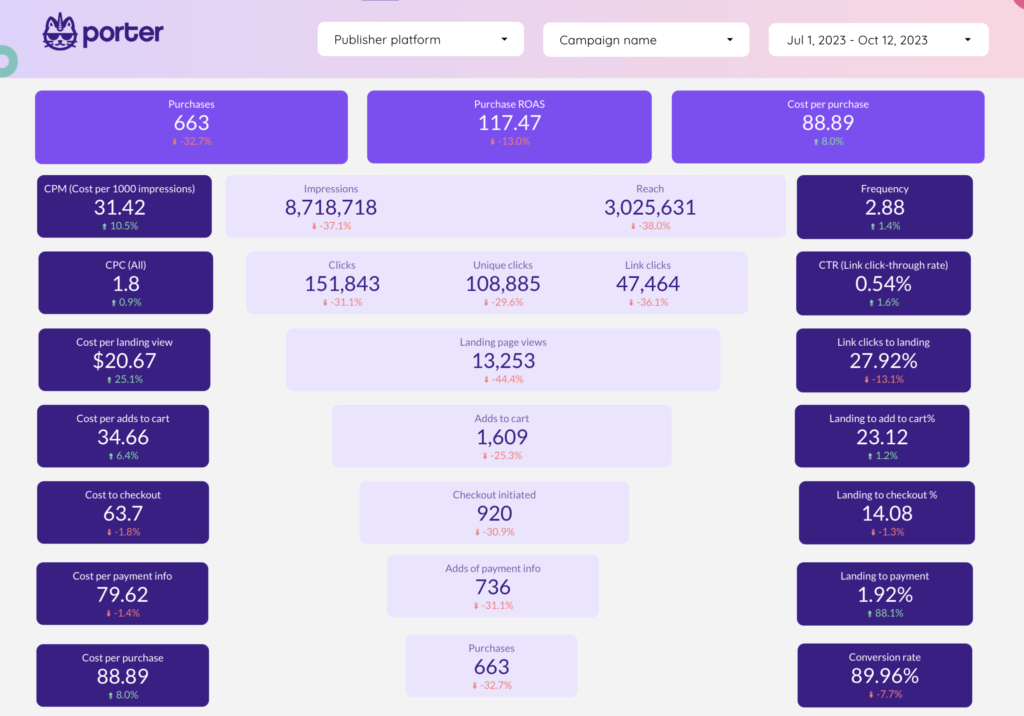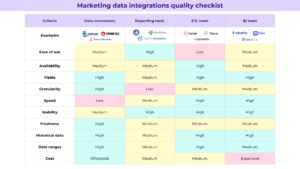Funnel.io: ETL platform with 500+ marketing/sales integrations.
- Managed data storage model for fast, stable data processing.
- Features no-code data transformations with a technical proficiency requirement.
- Suitable for large, data-driven marketing teams needing GDPR/SOC 2 compliance
.
- Can be costly due to capacity-based pricing and “flexpoints” system.
- High learning curve but provides top-notch customer support.
- Not ideal for small teams or simple marketing data reporting needs.
Funnel overview
Funnel.io is an ETL tool with 500+ marketing and sales integrations, 10+ destinations including data warehouses, visualization tools, spreadsheets. Has ‘managed data warehouse’ model, pre-storing data for speed, stability, potentially affecting data granularity, timeliness.
Known for data transformation layer enabling custom metrics, currency conversions, cross-channel normalization, and blending. No-code tool but requires high technical proficiency akin to spreadsheet power users.
Who Funnel is not for?
Data-driven marketing teams with a large volume of data, data sources, products, clients, and business lines, making working their data more complex.
Large and mid-market organizations that need to store their data in a datawarehouse and need to be GDPR and SOC 2 compliant.
Tech savvy arketing teams and agencies familiar with data analytics and automation
Reasons to seek Funnel alternatives
Users seek Funnel.io alternatives due to is its high costs:
- Capacity-based pricing rapidly reaches hundreds/thousands of dollars monthly.
- “Flexpoints” pricing is unclear.
- Funnel.io constantly increases prices.
Drawbacks:
- High learning curve, technical, full of settings, suited for tech-savvy marketers/analysts.
- Longer implementation process: setting up every table to pull data sources for reports. Other connectors directly integrate destinations, allowing more flexibility and granularity.
- Lack of certain fields and metric/dimension combinations.
- While many integrations, others offer more specific, uncommon fields for data cleaning and filtering.
- Slow data uploading due to delayed data syncing, taking hours to update, affecting users needing near real-time monitoring.
Some Funnel alternatives for marketing reporting automation include: Supermetrics, Porter Metrics, Windsor AI, Power My Analytics, Dataslayer, AgencyAnalytics, and Polar Analytics.
How to use Funnel?
Sign in to Funnel.io
Connect data: select and authenticate data sources and destinations.
Select fields: Choose the specific fields and metrics you wish to include in your report, a step that contrasts with more direct connectors that let you be more granular within the destination. From Funnel, for every query, you need to set up an additional table.
Combine Tables: Decide how to combine tables to create a comprehensive dataset.
Transformation: create custom metrics, dimensions, change currency conversions, normalize data.
Explore Data: Prior to exporting, use the Data Explorer to review and adjust your dataset to ensure it meets your reporting needs.
Configure Destinations: Add destinations (e.g., Google Sheets, BigQuery), inputting all required connection details.
Schedule Data Updates: Determine the update frequency to automatically refresh your data in the chosen destinations.
Monitor & Adjust: Regularly review your data flows, making adjustments to settings as required.
Analyze Data: Access and analyze your data within your chosen destinations for insights.
Funnel integrations
500+ data Sources for technical marketing teams or data analysts, including:
- Organic and paid Socia : Instagram Insights, LinkedIn Organic.
- Web Analytics: Google Analytics, Adobe Analytics, Mixpanel Cohorts.
- CRM and E-commerce: Salesforce, Shopify, Adtriba, INCRMNTAL.
Destinations:
- Spreadsheets: Google Sheets, Microsoft Excel.
- Visualization tools: Looker Studio, Tableau, Power BI.
- Data warehousing: Snowflake, Amazon S3, Google BigQuery, MongoDB.
Integrations pros
Utilizes a complex “flexpoints” pricing system calculated based on data sources and destinations. Has a free Starter plan with 350 flexpoints, $1,100/month Business plan with 3,500 flexpoints, and custom Enterprise pricing. Number of flexpoints varies by integration type.
Funnel plans description
- Starter:
Cost: Free
Users: Up to 5
Data: 250+ connectors, Storage on AWS S3
Flexpoints: 350 included
Support: Self-service and in-app
- Business:
Cost: $1,100/month
Users: Unlimited
Data: 250+ connectors, Data warehouses, 1x data storage on S3
Flexpoints: 3,500 included
Support: Guided onboarding and in-app
- Enterprise:
Cost: Custom
Users: Unlimited, with user roles and permissions
Data: 250+ connectors, Custom storage on S3, Data warehouses
Flexpoints: Custom
Support: Guided advanced setup, Priority in-app
Billing: Funnel.io offers montlhly plans but all of them are listed with annual billing
Free plan type: Funnel.io offers an unlimited free plan of 350 flexpoints that let users connect around 2-3 integrations to about 1-2 destinations like Google Looker Studio or Sheets. This might vary for the integrations type, and the free plan limits can be surpassed quickly.
User management: Starter plan lets you add 5 users (from 1000/mo, billed annually). All additional plans come with unlimited users.
Funnel reviews
G2 overall score: 4,5
Current reviews: +137
G2 ease of setup score: 8.7(Marketing Analytics Average: 8.5)
G2 ease of use score: 8.7 (Marketing Analytics Average: 8.5)
G2 quality of support score: 9.2 (Marketing Analytics Average: 9.0)
Funnel positive reviews
“What I like most about Funnel is how customizable it is. Within their Data Explorer, you can look at the data in any way you please and in any possible configuration. You can create custom metrics and dimensions and any type of filter imaginable.”
Funnel negative reviews
“Takes some time to wrap your head around, and the setup takes some time. Still some bugs in some connectors that haven’t been solved after a few months.”
“The token system seems extremely arbitrary and does not lend itself to value for money.”
“Modifying certain data nodes is a bit difficult, especially when looking for historical data for GA.”




